Chapter 1 – Numbers
Map
1.1
1.19

Timeline
1.1
1.19
Introduction
Can you imagine a world without numbers? It’s safe to say that society as we know it today would never have developed without numbers. The scientific and technological advances upon which society is built depend upon mathematics, which in turn depends upon numbers.
Despite their importance, the development of numbers remains mostly a mystery. That’s because the first ancient prehistoric people who likely developed simple methods of counting didn’t leave any records behind to explain themselves.
Common sense and ancient evidence points to the idea that numbers and counting began with the number one. Although they probably didn’t call it “one,” prehistoric people likely counted by ones and kept track by carving lines on a bone. 
Evidence that this occurred as long as tens of thousands of years ago can be found on an ancient artifact known as the Ishango Bone. It is one of the earliest, if not the earliest, mathematical manmade object. It was found in 1950 in the then-Belgian colony of the Congo (now the Democratic Republic of Congo). It is the bone of a large mammal, probably a baboon or large cat, and is approximately 25,000 years old. It is 10 cm long and has a distinct, organized series of notches. Looks like as a tally stick, doesn’t it?
1.1
1.1
1.1
Though its original purpose remains a subject of debate, the grouping of etchings on the bone suggests more advanced mathematics than just tallying. Can you find any possible number patterns among the numbers representing the groupings of tally notches?
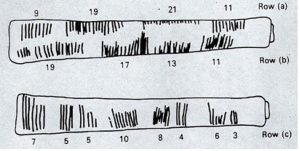
Number Systems
A number or numeral system is a system, writing or oral, for expressing numbers, The system we use now is called a decimal system and has 10 symbols with which we can express any number in the Universe. We are so used to seeing the symbols 1, 2, 3, 4, etc. that it may be somewhat surprising to see that many creative and innovative ways to compute and record numbers have existed and which still exist all over the world. That’s not to say our own system is not important or efficient. The fact that it has survived for hundreds of years and shows no sign of going away any time soon suggests that we may have finally found a system that works well and may not need further improvement, but only time will tell that whether or not that conjecture is valid or not.
Babylon – Why and how did humans start writing?
Have you ever wanted to live forever? What about cloning yourself? The miracle of writing allows you to do both. You can capture your thoughts and ideas eternally by writing them down. You can communicate with a written message to someone on the other side of the world while you are still right here. In a way, your thoughts have been cloned and now live in two places at the same time! If you wanted someone to thank for this subtle superpower you have inherited, you would need a time machine to take you back over five thousand years to the land of ancient Mesopotamia…
Although people in ancient times seem so distant, they still had many of the same needs that we do today. As ancient Mesopotamian society developed and grew more complex, it required a more effective way of communicating than just through human speech. The story of human writing began as a way for people to keep count of objects during trade. They used small clay tokens in a variety of shapes to symbolize different physical goods. Spheres, cones, and discs represented differing measurements of grain, while cylinders stood for livestock.
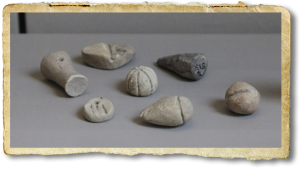
The tokens were enveloped inside clay balls that had a marking on them to show what type of token was inside. After a while, they realized it was unnecessary to have the token as well as the marking, and chose just to use a clay marking (much like how we use money to represent the value of goods). But, as the nature of goods became more detailed, they needed to create more and more types of markings. And, this exploration into a world of new symbols is how the Mesopotamians embarked on the journey of creating written language.
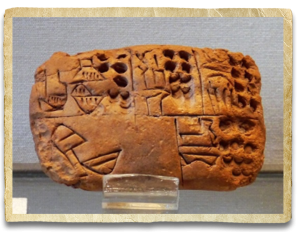
As time went on they were presented with new challenges. How to record a person’s name? It wouldn’t be possible to create a new symbol for every single name, so the Mesopotamians devised a strategy to reuse symbols to represent sounds. For example, if they wanted to write down the last name “Sontag,” they drew a circle sign in clay – since it already symbolized the sound of the spoken word “sun” – and then drew a label sign in clay to represent the word “tag.” This allowed them to pronounce the whole name just by reading the two symbols together. This method of naming is called the Rebus Principle. “Rebus,” in Latin, means “by things,” so the meaning here is that sounds can now be represented by pictograms (pictures of things).
We take writing for granted, but like many of the human achievements we rely on for our modern world to function, we have ancient cultures to thank for them. We truly stand on the shoulders of the giants of the past.
Do you want to see your monogram in Cuneiform, the way an ancient Babylonian might have written it? Click on the link from The University of Pennsylvania Museum of Archaeology and Anthropology https://www.penn.museum/cgi/cuneiform.php
1.2
1.1
1.2

The Babylonian number system uses base 60 (sexagesimal) instead of 10. Their notation is not terribly hard to decipher, partly because they use a positional notation system, just like we do. To us, the digit 2 can mean 2, 20 (2*10), 200 (2*10*10), and so on, depending on where it appears in a number. Similarly, to Babylonians ![]() can mean 2, 120 (2*60), 7200 (2*60*60) and so on, depending on where it appears in a number.
can mean 2, 120 (2*60), 7200 (2*60*60) and so on, depending on where it appears in a number.
1) What symbols did the Babylonians use to express numbers?
2) Calculate the value of:
a. ![]()
![]()
b. ![]()
![]()
c. ![]()
![]()
![]()
Example of Babylonians numbers:

![]()
d. How would Babylonians write 66? 666?
1.3
1.1
1.3
A granary of barley contains 2400 gur, where 1 gur equals 480 sila. If workers are to receive 7 sila of grain for a day’s work, how many men can be paid from this granary?
1.4
1.1
1.4
A woman weaves a textile that is to be 48 rods long. In one day, she weaves 1/3 rod. In how many days will she cut the textile from the loom?
Mayan Civilization – The Story of Pok-A-Tok
What comes to mind when thinking about the oldest team sport? Is it soccer? Polo? When we talk about ancient civilizations, much of the discussion centers around culture, architecture, famous kings and queens, but rarely do we shine a light on the sports played by the ancients. In fact, the earliest team sport on record comes from Mesoamerica over 3,500 years ago, and is profoundly linked to death, ritual, and the afterlife. The sport is known as Pok-A-Tok, and – player beware – losing a game could cost you your life…
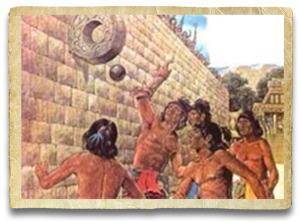
When Spanish explorers first landed in the New World and made contact with the Aztec people of Central America, they were fascinated by many things, one of which was an exotic Aztec sport played with a ball made of rubber, a material unknown in Europe at that time. A cross between soccer and basketball, Pok-A-Tok features two teams on a stone court both trying to get the ball up a slope and through a stone hoop. The catch? Players couldn’t use their feet or hands. The only way to pass and shoot the ball was with your head, shoulders, elbows, wrists, or most commonly, with your hips. Beyond the difficulty and athleticism of the gameplay itself, what made the sport so intriguing that the Spanish sent a team of Aztec players back to Spain to play for King Charles V himself?
For the Aztecs and their ancestors, the ancient Mayans, Pok-A-Tok was much more than a sport. It symbolized war, hunting, the battle for survival, and was a line of communication for them to the gods of the Mayan religion. Believing that the gods required a tribute of human blood, and human hearts, to keep the sun and moon in orbit, the Mayans would execute the captain, or sometimes the entire losing team, of a Pok-A-Tok game in a human sacrifice ritual! As scary as it seems, the Mayans had an entirely different view of life and death than we do today. Some legends even spoke of winning Pok-A-Tok captains bizarrely offering their own heads for decapitation! While this may sound counter-intuitive, to the Mayans, it was the ultimate honor since it was seen as winning a direct ticket to heaven without having to go through the thirteen steps needed to ascend to a peaceful afterlife.
Aside from the darker aspects of the game, Pok-A-Tok was also played ceremonially, as well as being used to resolve disputes between rival cities instead of resorting to warfare. With over a thousand Pok-A-Tok courts scattered across Mesoamerica, it is no surprise that the game played an integral role in ancient Mayan life. The question is, will it ever regain its popularity? And, if so, will the human sacrifice too?
1.5
1.1
1.5
Maya mathematics constituted the most sophisticated mathematical system ever developed in the Americas. The Maya counting system required only three symbols: a dot representing a value of one, a bar representing five, and a shell representing zero. These three symbols were used in various combinations, to keep track of calendar events both past and future, and so that even uneducated people could do the simple arithmetic needed for trade and commerce. That the Maya understood the value of zero is remarkable – most of the world’s civilizations had no concept of zero at that time.
The Maya used the vigesimal system for their calculations – a system based on 20 rather than 10. For example to us, the digit 1 can mean 1, 10 (1*10), 100 (1*10*10), and so on, depending on where it appears in a number. Similarly, to Mayans a dot can mean 1, 20 ((1*20), 200 (2*20*20), and so on, depending on where it appears in a number. This means that instead of the 1, 10, 100, 1,000 and 10,000 place values of our number system, the Maya used 1, 20, 400, 8,000 and 160,000 place values.
Maya numbers were written from bottom to top, rather than horizontally. As an example of how they worked, three was represented by three dots in a horizontal row; 12 was two bars with two dots on top; and 19 was three bars with four dots on top. Numbers larger than 19 were represented by the same kind of sequence, but a dot was placed above the number for each group of 20. Thirty-two, for example, consisted of the symbols for 12, with a dot on top of the whole thing representing an additional group of 20. The system could thus be extended infinitely.
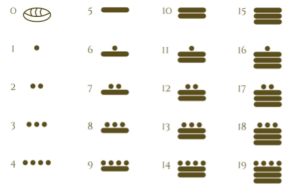


a. Find the values of the numbers

b. Write numbers 85, 121, 2222 in Mayan numerals
Medieval Europe – The story of prohibited numbers.
Have you ever wondered where the numbers we use came from? The story behind our numerical system began in the middle ages, journeyed across the world and into the present day – but, did you know there was once a time where using them was forbidden?
Originating in ancient India, our number system made its maiden voyage into the wider world after being discovered by Arabic invaders in the year 711. The Arabs adopted the new system and introduced it into Western Europe, however, European authorities were not interested in using it, and even went as far as to outlaw it entirely for hundreds of years! Even as late as the 12th century, many Italian cities still banned the system’s use in contracts and official documents, favouring Roman numerals despite the fact that the Indo-Arabic method was more convenient for representing large numbers and performing multiplication and division. With that in mind, what reason could there have been for Europe to shun such a superior system?
In the middle ages, mathematics was most commonly used in trade and commerce. Since making calculations using Roman numerals could be difficult, European traders used a device called an abacus in order to simplify the process. 
While the abacus is still used today in East Asia, India, and Russia, the Indo-Arabic system is undoubtedly more effective for a wide range of functions. The European traders came to that same conclusion after their Arabian counterparts crossed the Mediterranean Sea and introduced the new system. The problem was, despite its efficiency, the Indo-Arabic numerical system contained some loopholes for those unfamiliar with it. Traders could easily write one number and claim later that they had meant some other number. For example, one could write down the price of an item as the number sixteen, but later claim the price was actually ninety-one by alleging the buyer viewed the number upside-down. The Arabian traders could make out these subtle differences, but the locals were not so familiar with them.
Another reason why the European powers were cautious about changing their current system was that Indo-Arabic numerals contained the number zero. On top of being unknown and difficult to understand for Europeans, the idea of a zero number was also problematic for them because of its connection to the concept of debt. At that time, the use of debt was considered to be immoral in Europe. The fear was that zero was associated with negative numbers (AKA debt), and its use would eventually lead to the use of debt in their society.
During the French Revolution of 1789, the abacus was banned in schools and administrations, which gave an opportunity for Indo-Arabic numerals to be used throughout Europe. Its zigzagging journey took over a thousand years to reach its destination as the most prominent numerical system in the world, but its story is not finished yet. What does the future hold for Indo-Arabic numerals? Could it one day be dethroned by a better system waiting to be discovered?
1.6
1.1
1.6
There is a tree with 100 branches; each branch has 100 nests; each nest, 100 eggs; each egg, 100 birds. How many nests, eggs and birds are there?
1.7
1.1
1.7
Three hundred pigs are to be prepared for a feast. They are to be prepared in three batches on three successive days with an odd number of pigs in each batch. Can this be accomplished?
1.8
1.1
1.8
A leech invited a slug for lunch a leuca away. But he could only crawl an inch a day. How long will it take the slug to get his meal? [1 leuca = 1500 paces; 1 pace = 5 feet.]
1.9
1.1
1.9
A certain man had in his trade four weights with which he could weigh integral pounds from 1 up to 40. How many pounds was each weight?
1.10
1.1
1.10
I have a cloak 100 cubits long and 80 cubits wide. I wish to make small cloaks with it; each small cloak is 5 cubits long, and 4 wide. How many small cloaks can I make
1.11
1.1
1.11
A father, when dying, gave to his sons 30 glass flasks, of which 10 were full of oil, 10 were half full, and the last 10 were empty. Divide the oil and the flasks so that each of the three sons received equally of both glass and oil.
1.12
1.1
1.12
A king ordered his servants to collect an army from 30 manors in such a way that from each manor he would take the same number of men he had collected up until then. The servant went to the first manor alone; to the second he went with one other; to the next he took three with him. How many were collected from the 30 manors?
1.13
1.1
1.13
A gentleman has a household of 30 people and orders that they be given 30 measures of grain. He directs that each man should receive 3 mea¬sures, each woman 2 measures, and each child 1/2 measure. How many men, women, and children are there?
1.14
1.1
1.14
A man wanting to build a house contracted with six builders, five of whom were master builders, and the sixth an apprentice, to build it for him. He agreed to pay them a total of 25 pence a day, with the apprentice to get half the rate of a master builder. How much did each receive per day?
1.15
1.1
1.14
A man in the east wanted to buy 100 assorted animals for 100 shillings. He ordered his servant to pay 5 shillings for a camel, 1 shilling for an ass, and 1 shilling for 20 sheep. How many camels, asses, and sheep did he buy?
Egypt – The girl with the rose-red slippers or Egyptian Cinderella
Ancient Egypt is known for its great civilization, pyramids, and art. But, did you know they also have their own version of Cinderella? Known as The Girl with the Rose-Red Slippers, the story follows the unpredictable life of a girl named Rhodopis…
Born in ancient Greece, Rhodopis was carried away by pirates as a child, and sold to a wealthy man on the island of Samos. As the years passed, Rhodopis blossomed into a beautiful young woman, and yearned to break free of the bonds of slavery. Her greedy owner was so astonished at how beautiful she had become, he realized she was now worth at least twice as much as he initially paid. So, he sent her to the wealthy city of Naucratis, in ancient Egypt, to be sold at a slave-auction.
Rhodopis caught the attention of a man named Charaxos, who was so fascinated by her beauty that he bought her before anyone else could. After hearing the heart-wrenching story of her childhood, Charaxos was struck by a deep sense of compassion, and showered her with gifts. He bought her a house with a garden, fancy clothing, jewelry, and her most prized possession of all: a pair of rose-red slippers…
One day as Rhodopis was bathing in her pool, with her misfortunes a distant memory, an eagle swooped down from the sky into her garden, clutched her rose-red slippers in its talons and flew away. Rhodopis wept at the loss of her treasured slippers, and felt even worse losing a gift given by the generous Charaxos.
Far away south, in the valley of the Nile, lived Amaris, the pharaoh of Egypt. One day, while roaming the courtyard of his great palace, the pharaoh was visited by the very same eagle, who flew down and plunked the rose-red slippers at his feet. The pharaoh believed it to be an omen from the gods, since the ancient Egyptian god Horus was a man with the head of a bird. The pharaoh became obsessed with finding the owner of the rose-red slippers, convinced she must be his true love. 
He sent out his messengers to scour the land in search of Rhodopis. When they reached Naucratis and heard stories of Rhodopis’ beauty, they knew she must be the future queen. When the messengers knocked at her door, she couldn’t believe her eyes – her rose-red slippers had miraculously returned!
She was escorted back to meet the pharaoh, who offered his hand in marriage. And, just like that, Rhodopis went from slave to queen of Egypt. The moral of the story is that life is a long, winding road where hardship can sometimes lead to good fortune.
1.16
1.1
1.13
There is an estate that contains 7 houses; each house has 7 cats; each cat catches 7 mice; each mouse eats 7 spelt of seeds; each spelt was capable of producing 7 hekats of grain. How many things were in the estate?
1.17
1.1
1.14
Suppose a scribe tells you that four overseers have drawn 100 great quadruple hekats of grain, and their work gangs consist of 12, 8, 6, and 4 men. How much grain does each overseer receive?
1.18
1.1
1.15
The Egyptians had a number system using seven different symbols:
- 1 is shown by a single stroke.
- 10 is shown by a drawing of a hobble for cattle.
- 100 is represented by a coil of rope.
- 1,000 a drawing of a lotus plant.
- 10,000 is represented by a finger.
- 100,000 a tadpole or frog
- 1,000,000 figure of a god with arms raised above his head.
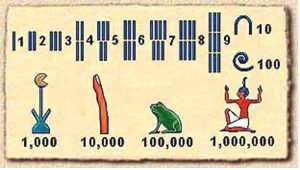
To read Egyptian numbers you have to add the values of the symbols describing a number:

The scene below depicts a cattle count done by an Egyptian scribe some 4000 years ago. It was found on the walls in one of the ancient Egyptian pyramid which was a tomb of a rich man. The scene would have depicted the wealth of the tomb owner and the depiction on the tomb wall also meant the tomb owner would have these animals with him in the afterlife.

Can you read Egyptian numbers and calculate:
- a) horned cattle on the left
- b) animals (cows?) right behind them
- c) goats on the right in the middle row
- d) donkeys in the bottom row on the left
- e) goats in the bottom row on the right
Greece – 300 Spartans and the Battle of Thermopylae
Greece. 300 Spartans and the Battle of ThermopylaeOne ancient battle above all others has achieved a legacy as the most famous last stand of all time: The Battle of Thermopylae. In this real life David vs. Goliath story, a small army of just a few thousand Greek warriors somehow defied impossible odds to defeat a colossal Persian army of nearly a quarter of a million soldiers! How did they do it? And, what made this Greek army so special that their voices continue to echo in modern times?
The story begins in the ancient Greek city-state of Sparta. This unique society was set apart from its neighbors because of its deep commitment to warrior-culture. In fact, their fighting force was so exceptional, they were the only Greek city to survive without defensive walls. Why were their soldiers so effective that the outside world viewed them as invincible?
Firstly, training began during childhood! Recruited at just the age of seven, young soldiers’ educational paths forced them to leave home and join a squad known as aghéle where they were all treated equally, however, extremely unpleasantly. Their hair was shaved off, they were forced to walk only in bare feet, and had to live without clothing no matter what the weather conditions were. On top of that, their thirteen year-long boot camp consisted of endless tests of their strength and skill, and absolute obedience to adults – all in the name of molding the perfect citizen.
By the time young Spartans reached the age of twenty, they were a step away from admission into the Spartan army, but first had to pass one final death-defying test: the krypteìa. The cruel challenge, meaning “something that takes place secretly,” involved one whole year of wandering alone barefoot, and surviving only on what they could hunt, forage, and steal for themselves. Beyond that unimaginable hardship, young Spartans were required to find and kill a member of the Spartan servant class, known as a Helot. Once the test was passed, they were given a red cloak and a shield, permitted to grow their hair back, and were granted membership into a spectacular military order that was unmatched by any other in the ancient world!

The Spartan’s reputation for excellence in combat did not, however, stop neighboring kingdoms from attempting to invade their country. In 480 B.C., Xerxes, King of Persia, sent an army of 242,000 troops into ancient Greece, and so began one of the most legendary military clashes of the ancient world. King Leonidas of Sparta knew that his army of 6,700 soldiers needed an excellent strategy to stop the Persian invasion, and so he chose to meet them head on at the pass of Thermopylae, a geographic bottleneck that caused the Persians to file through in a line. This allowed the Spartans to engage them man to man, rather than being swamped by the outnumbering force. Before the attack, Xerxes sent a message to the Spartans to accept defeat and surrender their weapons, to which Leonidas replied “molon labe,” which translates to “come and take them.” In doing so, King Leonidas knew he was sending himself and his soldiers to their deaths, but a Spartan would never accept defeat, especially when it came to protecting his homeland.
After three days of successfully defending the pass of Thermopylae, tragedy and treachery were visited upon King Leonidas and his men. A local resident named Ephialtes is said to have betrayed his own Greek army by revealing a secret path to Xerxes that led around the pass of Thermopylae. Now outflanked by the Persians, Leonidas realized the battle could not be won, and dismissed the majority of his army while remaining to fight alongside three hundred Spartans. The Persian army successfully defeated the Spartans, but not after suffering many more casualties than their highly skilled opponents.
Despite the loss at Thermopylae, the Greeks were able to regroup and mount a successful attack against the Persian armada under the naval command of Themistocles in the Battle of Salamis in late 480 B.C. Afraid of being trapped in Europe, Xerxes withdrew his army back to Asia, but lost most of them to starvation and disease during the process. With the Persians’ losing the upper hand, the Spartans assembled at full strength and defeated the Persians decisively at the Battle of Plataea, bringing the Greco-Persian war to an end, and with it, a conclusion to the Persian empire’s advances into Europe.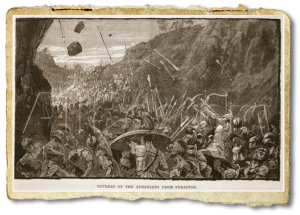
The story of the Battle of Thermopylae and the famous last stand of its three hundred Spartan soldiers has left an indelible mark on ancient and modern writers alike, even being made into three Hollywood movies! Its ability to capture the determination of the human spirit stands the test of time as an enduring tale of courage and conviction in the face of seemingly insurmountable odds.
1.19
1.1
1.16
Ancient Greece was not a country as we know it today. It was composed of city-states also known as a polis. Among the main poleis were Athens and Sparta. While Spartans were mostly warriors, Athenians loved arts, philosophy and mathematics. They left us many mathematical problems and puzzles. Try to solve one of them.
a and b are two numbers. Order the following expressions from least to greatest and defend your solution.
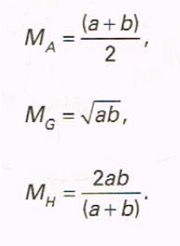
1.20
1.1
1.17
Given, four whole numbers where, if added together three at a time, their sums are 20, 22, 24, and 27. What are the numbers?

